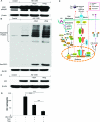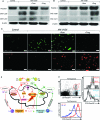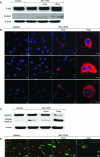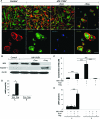Functional proteomic analysis for regulatory T cell surveillance of the HIV-1-infected macrophage
- PMID: 20954747
- PMCID: PMC3108468
- DOI: 10.1021/pr1009178
Functional proteomic analysis for regulatory T cell surveillance of the HIV-1-infected macrophage
Abstract
Regulatory T cells (Treg) induce robust neuroprotection in murine models of neuroAIDS, in part, through eliciting anti-inflammatory responses for HIV-1-infected brain mononuclear phagocytes (MP; macrophage and microglia). Herein, using both murine and human primary cell cultures in proteomic and cell biologic tests, we report that Treg promotes such neuroprotection by an even broader range of mechanisms than previously seen including inhibition of virus release, killing infected MP, and inducing phenotypic cell switches. Changes in individual Treg-induced macrophage proteins were quantified by iTRAQ labeling followed by mass spectrometry identifications. Reduction in virus release paralleled the upregulation of interferon-stimulated gene 15, an ubiquitin-like protein involved in interferon-mediated antiviral immunity. Treg killed virus-infected macrophages through caspase-3 and granzyme and perforin pathways. Independently, Treg transformed virus-infected macrophages from an M1 to an M2 phenotype by down- and up- regulation of inducible nitric oxide synthase and arginase 1, respectively. Taken together, Treg affects a range of virus-infected MP functions. The observations made serve to challenge the dogma of solitary Treg immune suppressor functions and provides novel insights into how Treg affects adaptive immunosurveillance for control of end organ diseases, notably neurocognitive disorders associated with advanced viral infection.
Figures






Similar articles
-
Neuromodulatory activities of CD4+CD25+ regulatory T cells in a murine model of HIV-1-associated neurodegeneration.J Immunol. 2009 Mar 15;182(6):3855-65. doi: 10.4049/jimmunol.0803330. J Immunol. 2009. PMID: 19265165 Free PMC article.
-
Phenotypic and functional switch of macrophages induced by regulatory CD4+CD25+ T cells in mice.Immunol Cell Biol. 2011 Jan;89(1):130-42. doi: 10.1038/icb.2010.70. Epub 2010 Jun 1. Immunol Cell Biol. 2011. PMID: 20514074
-
Cyclic AMP is a key regulator of M1 to M2a phenotypic conversion of microglia in the presence of Th2 cytokines.J Neuroinflammation. 2016 Jan 13;13:9. doi: 10.1186/s12974-015-0463-9. J Neuroinflammation. 2016. PMID: 26757726 Free PMC article.
-
Proteomic analysis of HIV-infected macrophages.J Neuroimmune Pharmacol. 2011 Mar;6(1):89-106. doi: 10.1007/s11481-010-9253-4. Epub 2010 Dec 14. J Neuroimmune Pharmacol. 2011. PMID: 21153888 Free PMC article. Review.
-
Brain regulatory T cells.Nat Rev Immunol. 2024 May;24(5):326-337. doi: 10.1038/s41577-023-00960-z. Epub 2023 Dec 1. Nat Rev Immunol. 2024. PMID: 38040953 Review.
Cited by
-
Proteomics, biomarkers, and HIV-1: A current perspective.Proteomics Clin Appl. 2016 Feb;10(2):110-25. doi: 10.1002/prca.201500002. Epub 2015 Jul 8. Proteomics Clin Appl. 2016. PMID: 26033875 Free PMC article. Review.
-
Beneficial and Detrimental Effects of Regulatory T Cells in Neurotropic Virus Infections.Int J Mol Sci. 2020 Mar 2;21(5):1705. doi: 10.3390/ijms21051705. Int J Mol Sci. 2020. PMID: 32131483 Free PMC article. Review.
-
Quantitative proteomic analysis of exosomes from HIV-1-infected lymphocytic cells.Proteomics. 2012 Jul;12(13):2203-11. doi: 10.1002/pmic.201100376. Proteomics. 2012. PMID: 22807456 Free PMC article.
-
Immune regulation and evasion of Mammalian host cell immunity during viral infection.Indian J Virol. 2013 Jun;24(1):1-15. doi: 10.1007/s13337-013-0130-7. Epub 2013 Mar 15. Indian J Virol. 2013. PMID: 24426252 Free PMC article.
-
Cell delivery of therapeutic nanoparticles.Prog Mol Biol Transl Sci. 2011;104:563-601. doi: 10.1016/B978-0-12-416020-0.00014-0. Prog Mol Biol Transl Sci. 2011. PMID: 22093229 Free PMC article.
References
-
- Robertson K. R.; Smurzynski M.; Parsons T. D.; Wu K.; Bosch R. J.; Wu J.; McArthur J. C.; Collier A. C.; Evans S. R.; Ellis R. J. The prevalence and incidence of neurocognitive impairment in the HAART era. AIDS 2007, 21 (14), 1915–21. - PubMed
-
- Antinori A.; Arendt G.; Becker J. T.; Brew B. J.; Byrd D. A.; Cherner M.; Clifford D. B.; Cinque P.; Epstein L. G.; Goodkin K.; Gisslen M.; Grant I.; Heaton R. K.; Joseph J.; Marder K.; Marra C. M.; McArthur J. C.; Nunn M.; Price R. W.; Pulliam L.; Robertson K. R.; Sacktor N.; Valcour V.; Wojna V. E. Updated research nosology for HIV-associated neurocognitive disorders. Neurology 2007, 69 (18), 1789–99. - PMC - PubMed
-
- McArthur J. C.; Brew B. J.; Nath A. Neurological complications of HIV infection. Lancet Neurol. 2005, 4 (9), 543–55. - PubMed
-
- Everall I. P.; Hansen L. A.; Masliah E. The shifting patterns of HIV encephalitis neuropathology. Neurotox. Res. 2005, 8 (1−2), 51–61. - PubMed
Publication types
MeSH terms
Substances
Grants and funding
LinkOut - more resources
Full Text Sources
Research Materials

